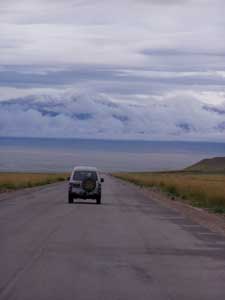
| WEEK 2: Mark Appleton writing from Lhasa, 16 September 2002 |
||||
|
Earlier Chinese Whispers: |
||||
The run from Xi'an to Lanzhou, as noted in my last missive, will probably end up being the longest on the event. It registered just over 664km on my Brantz tripmeter, but surprisingly did not feel that hard. The first and last sections are on modern expressways, and the middle section follows the route of the original Silk Road, along a river valley on a two-lane highway with relatively little traffic. It took us about 10 1/2 hours to cover the distance, but this included a diversion enforced by the closure of over 100km of expressway to ease the passage of an important official. Of course, this sort of thing should not be a worry during the event in September 2003, as we will have the full co-operation of the Public Security arranged by our friends at the FASC. From Lanzhou to Xining is a relatively easy run after the distance of the previous day and the toughness of those to come. The route is pleasant and the highlight of the day undoubtedly comes just before the end when we visit the Ta Er Monastery. Noted as one of the six most important monasteries of the Yellow Hat sect of Tibetan Buddhism, it is like something out of a dream. Passing through the front gate, cars are parked around an impressive line of stupas, and further exploration reveals more delights with every corner. Again, the following run from Xining to Qinghai Hu is relatively straight -forward and short at only 175 km. This will allow us to fettle our cars and prepare ourselves to go to altitude during the morning; or indeed visit the great mosque which is rumoured to contain murals of a Chinese version of the Karma Sutra within locked rooms. After a late morning start, we climb steadily to our next overnight halt by the shores of Qinghai Hu. This is the largest salt-water lake in China, and is famed for its bird life during the springtime - although there are still plenty around in September. We stay in a resort complex where each chalet is decorated in the style of a traditional yurt - they're actually pretty plush when you get inside, and we will use the newly refurbished ones. At 3,200m this will serve as a good acclimatisation stop for the higher terrain to come. The second of the really long days gets us from Qinghai Hu to Golmud. We cover 622km of empty, modern 2-lane highway s, skirting along the edge of the Tibetan plateau. Before we do this, we must cross the Qinghai Nan Shane Mountains, climbing to 3,817m as we do so. From there, there are big views of plains, mountains, and the Tsaidam Desert that we skirt on the way to our overnight halt in Golmud. We have a choice of two hotels: both newly refurbished (Chinese) three star establishments and both quite acceptable. The main street is pretty lively and there is a choice of restaurants. From Golmud we climb onto the Tibetan Plateau and views are the order of the day - or the next three days in fact. Sweeping grassland, steep mountains, dry river beds, nomadic yak herders and very little habitation. In fact, the only people you see are fellow drivers and the workers on the ambitious Golmud to Lhasa railway project (who are also kindly upgrading the road). This remoteness means our choice of accommodation is limited. We have plumped for a military guesthouse in the two-yak town of Tuotuohe for two reasons. The first is that it is just next to the first bridge over the Yangtze, and the second is that it is the best place for at least 100km in each direction. At 4,542m, water boils at around 75 degrees Celsius. This means that rice does not cook too well, and therefore the best meal available is a hearty bowl of noodles with perhaps some egg or meat. Up with the sun the following morning we woke the petrol station attendant (who lives in the building that houses the pumps) and purloined 50 or so litres of his finest (and only) grade of petrol before heading across the plateau. The rail workers have not got this far, so the views are uninterrupted and truly breathtaking. The highest point of the day is the Tanggula Shanku pass that forms the border between the Chinese region of Qinghai and the Tibetan Autonomous Region (TAR). At 5,220m, this will also be the highest point on the whole event - suitably adorned with prayer flags and surrounded by snowy mountains. Finishing the day in Nagqu we discovered that the highest 2-star hotel in the world (4,525m) is not quite big enough to hold us all, so we will also have to use the highest 1-star hotel in the world. Both are clean and have running hot and cold water. We descend the following day to Lhasa - 325 km into steadily more hospitable terrain. We start to find fields of barley and the number of yak herds increases dramatically. The views also change, with no more great-plains, but valleys and fast flowing rivers - strangely reminiscent of the glens of Scotland but on a larger scale and with a different breed of hairy cow. Participants on the Great Tour of China in September 2003 will stay at the 4-star Lhasa Hotel, which is inviting and relaxing. We have a rest day here to explore the delights of this once Forbidden City; the Dalai Lama's palace, the Jokhang Temple and the bustling Barkhor market. Or you could just put your feet up by the pool and enjoy a Yak burger from the Hard Yak Café. Tomorrow, we start on the road to Everest Base Camp. One of the locals that we were talking to today, claim the entire route is tarmac. I find it hard to believe, but we'll see. |
||||



